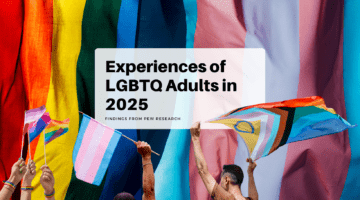Sex Question Friday: Is Bisexuality More Common In Women Or Men?
July 31, 2014 by Justin Lehmiller
Every Friday on the blog, I answer people’s questions about sex, love, and relationships. This week’s question comes from a reader who wanted to know more about the topic of bisexuality:
“I have always heard that there are more bi females than there are bi males. Is this true and, if so, why?”
Great questions! As for whether there are more bisexual females than males, the answer depends on what you mean by “bisexual.” If you look at people who adopt a bisexual identity label, this would appear to be true. Most national U.S. sex surveys I have seen report that a higher number of women identify as bisexual compared to men. For example, in the 2009 National Survey of Sexual Health and Behavior (NSSHB), 3.6% of women identified as bisexual compared to 2.6% of men. Other studies have found even larger sex differences, such as the 2006-2008 National Survey of Family Growth, which put the numbers at 3.5% of women and 1.1% of men.
Alternatively, however, if you consider sexual behavior patterns, you might come to a somewhat different conclusion. Several studies have found that bisexual behavior patterns (i.e., a sexual history that includes both male and female partners) are more common among men than they are among women. For instance, in the 1994 National Health and Social Life Survey (NHSLS), 5.8% of men and 3.3% of women reported having both male and female sexual partners in their lives.
As you can see, sexual identity and sexual behavior are telling us two different things. I would hypothesize that a big part of the reason for this is likely because people harbor more negative attitudes toward male bisexuality than female bisexuality. For instance, compared to female bisexuals, people are more likely to think that male bisexuals are secretly gay or just trying to get attention (i.e., male bisexuals are more likely to have their motives questioned) [1]. Likewise, while a large number of heterosexual men find the idea of female bisexuality appealing, heterosexual women don’t necessarily feel the same way about male bisexuality. Together, all of this undoubtedly puts more pressure on men to shy away from a bisexual identity and to adopt an exclusively heterosexual or gay identity instead. I suspect that if male bisexuality were more socially acceptable, you might not find as much of a difference in the number of men and women who identify as bisexual.
That said, there are some who might argue that, regardless of how accepting society is of bisexuals, female bisexuality will always be more common because women have an inherently more “flexible” sexuality. As some evidence of this, several studies have demonstrated that women tend to have a non-specific genital arousal pattern (i.e., women show high levels of genital arousal in response to both male and female sexual stimuli), whereas men’s is more category-specific (i.e., men tend to show much more genital arousal to one sex than the other) [2]. Why? Some have hypothesized that it is more evolutionarily adaptive for women to have a “flexible” sexuality than it is for men (e.g., consider the alloparenting hypothesis).
At the same time, however, other lines of research suggest that having a flexible or fluid sexuality isn’t necessarily specific to one sex (learn more here). As you can see, the question of whether there are more bisexual women or men out there is not an easy one to answer and much more research is needed in this area.
For previous editions of Sex Question Friday, click here. To send in a question for a future edition, click here.
Want to learn more about Sex and Psychology? Click here for previous articles or follow the blog on Facebook (facebook.com/psychologyofsex), Twitter (@JustinLehmiller), or Reddit (reddit.com/r/psychologyofsex) to receive updates.
[1] Yost, M.R., & Thomas, G.D. (2012).Gender and binegativity: Men’s and women’s attitudes toward male and female bisexuals. Archives of Sexual Behavior, 41, 691-702.
[2] Chivers, M. L., Rieger, G., Latty, E., & Bailey, J. M. (2004). A sex difference in the specificity of sexual arousal. Psychological Science, 15, 736–744.
Image Source: Wikimedia Commons

Dr. Justin Lehmiller
Founder & Owner of Sex and PsychologyDr. Justin Lehmiller is a social psychologist and Research Fellow at The Kinsey Institute. He runs the Sex and Psychology blog and podcast and is author of the popular book Tell Me What You Want. Dr. Lehmiller is an award-winning educator, and a prolific researcher who has published more than 50 academic works.
Read full bio >


